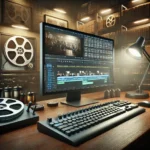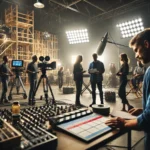Sound design is one of the most underappreciated yet essential components of filmmaking. It involves the art of creating and manipulating audio elements that make a film’s narrative and emotional depth richer. From ambient sounds to dialogue, sound design shapes how audiences experience a movie. In this article, we’ll explore the key elements of sound design, its role in cinematic storytelling, and how it enhances the emotional engagement of the audience.
The Role of Sound Design in Film
Sound design plays an integral part in creating the film’s atmosphere, setting the tone, and building tension or excitement. While visual elements provide the imagery, sound adds texture, making the experience more immersive and dynamic. Without a well-crafted soundscape, a film can feel incomplete, no matter how impressive the visuals are.
Key functions of sound design in films include:
- Establishing Location: The background sounds in a scene help the audience to recognize the setting (e.g., the hustle and bustle of a city vs. the calmness of a forest).
- Setting the Mood: The use of sound can dictate the emotional tone of a scene—whether it’s eerie silence in a horror film or energetic music in an action sequence.
- Guiding the Audience’s Focus: Sound design can highlight important story elements, such as enhancing the sound of footsteps to indicate danger or using echoes to signify a vast, empty space.
The Key Components of Sound Design
A successful sound design integrates various audio elements to create a cohesive and immersive experience. The key components include:
- Dialogue: Clear and well-recorded dialogue is essential for delivering the film’s narrative. Good sound design ensures that conversations remain intelligible, even when surrounded by other audio elements.
- Sound Effects (SFX): These are artificially created or enhanced sounds that mimic real-world noises or completely fictional ones (such as the whoosh of a lightsaber). They add realism and depth to the visual action on-screen.
- Foley: Foley artists create custom sounds that match the on-screen actions, such as footsteps, rustling clothes, or clinking objects. These are recorded in post-production and help enhance the sense of realism.
- Music: A film’s score or soundtrack can dramatically affect the audience’s emotional response. It can build tension, signal an upcoming action, or provide relief after a climactic scene.
- Ambience: These background sounds provide context for the environment and help establish a scene’s location. For example, a scene set in a park may include birds chirping and children playing in the distance.
Techniques for Creating the Perfect Soundscape
Creating an effective soundscape requires both technical skill and creative insight. Here are some techniques sound designers use to achieve impactful results:
- Layering Sounds: Sound designers layer multiple sounds to create a rich, multidimensional experience. For example, in a city scene, the audio may include layers of traffic noise, people chatting, and distant sirens to replicate the complexity of urban life.
- Using Silence: Strategic use of silence can be just as powerful as sound. By removing audio, filmmakers can emphasize moments of tension or introspection.
- Dynamic Range Control: Properly balancing loud and quiet moments allows the audience to engage with the film more naturally. Overloading scenes with constant loud sounds can lead to fatigue, while too much silence can cause disengagement.
- Creative Use of Audio Distortion: Distorting sound can be used to reflect a character’s mental state or to enhance a surreal or dreamlike sequence. For example, a distorted heartbeat could signify panic or anxiety.
Sound Design in Different Genres
Different film genres rely on sound design in unique ways to enhance their storytelling:
- Horror Films: Sound is often used to create tension and unease. Creepy ambient noises, sudden loud bursts, and eerie silence contribute to the fear factor.
- Action Movies: Explosive sound effects, fast-paced music, and dynamic soundscapes are crucial for maintaining the excitement and adrenaline of action scenes.
- Science Fiction and Fantasy: In these genres, sound design often involves creating entirely new soundscapes for futuristic or fantastical worlds. These films rely heavily on sound to make the unreal seem real.
The Collaboration Between Directors and Sound Designers
Great sound design comes from close collaboration between the director and the sound design team. Directors often have a vision of how they want the film to sound, and it’s up to the sound designers to translate that vision into reality. Together, they decide on the style, tone, and emotional impact of the sound.
For example, in “Inception,” the booming sound effects and atmospheric noises were meticulously crafted to reflect the dreamlike nature of the plot. In contrast, “A Quiet Place” used sound—or the absence of it—as a central element to the film’s tension, where even the slightest noise signaled danger.
Conclusion: Sound as a Storytelling Tool
In conclusion, sound design is far more than just adding background noise or music to a film. It’s a crucial storytelling tool that influences how we perceive characters, settings, and emotions. A well-designed soundscape enhances immersion, draws viewers deeper into the story, and elicits emotional responses that visuals alone cannot achieve.
The next time you watch a film, pay attention to the sound. From the subtle rustling of leaves to the thunderous roar of an explosion, each sound contributes to the cinematic experience, enriching the story in ways that often go unnoticed but are deeply felt.


